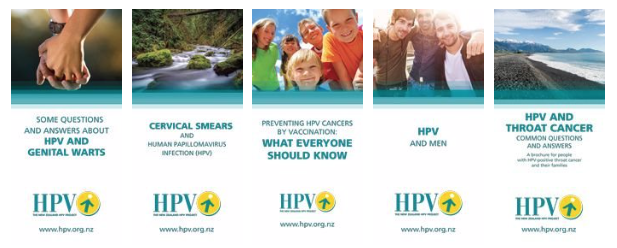STIEF News March 2020
In this issue:
- International HPV Awareness Day
- HPV FAQs
- HPV vaccine FAQs
- HPV vaccine student health promotion campaign
- HPV and gay, bisexual and other men who have sex with men FAQs
- HPV research grant opportunity
- Key HPV information for people with HPV
- HPV patient information pamphlets - new format
- Give your cervix some screen time
International HPV Awareness Day

The 4th of March marks International HPV Awareness Day which was inaugurated in 2018 by the International Papillomavirus Society. The annual campaign day encourages everyone to take action to learn about HPV, and how to manage the risk of HPV-associated cancers.
This issue of STIEF News is dedicated to HPV with a focus on addressing a number of HPV-related frequently asked questions (FAQs).
HPV FAQs
Extracted from the New Zealand HPV Project Guidelines for the Management of Genital, Anal and Throat HPV Infection in New Zealand 9th Edition - 2017.
What are the consequences of HPV infection?
- Most HPV infections are asymptomatic and of no consequence.
- HPV causes all anogenital warts – 90% of which are caused by non-oncogenic HPV 6 or 11.
- Persistent infection with oncogenic HPV types such as HPV 16 and 18 is responsible for a portion of intraepithelial neoplasia and cancers of the anogenital tract and oropharynx (cervical 100%, vaginal 90%, anal 80%, penile 50%, vulval 40%, oropharynx 26%).
- Although genital warts and genital tract cancers are declining, HPV-associated head and neck cancers and anal cancers are increasing – especially in men.
Does natural infection induce protective immunity?
- Not always. Current evidence suggests that overall naturally acquired immunity is unlikely to be effective because of the ability of the virus to evade the immune system. Previous infection does not necessarily create long term immune memory so does not prevent future re-infection with the same HPV type.
Does reactivation of latent HPV occur?
- For most people HPV infection is transient and becomes undetectable by DNA testing within 6-12 months. HPV infection can remain latent and may reactivate years later. It is not possible to detect HPV in its latent state so it is not possible to know whether in some cases the immune system has completely cleared the virus or whether the virus remains latent at an undetectable level.
Can asymptomatic people be tested for HPV?
- There is no available test to determine the HPV status of a person.
- Current laboratory assays for HPV DNA detect only particular high risk types (in order to guide clinical management in cervical screening) so cannot be used as a screening test for ‘all HPV types’.
What are the important points to know about HPV-associated anal cancer?
- The incidence of anal cancer is increasing and the burden of disease is highest in men who have sex with men (MSM) and HIV positive MSM.
- There is no effective method (including anal cytology/smear) for screening for anal cancer. Annual digital anorectal examination (DARE) is recommended for HIV positive MSM who are aged 50 years or over (see https://www.ashm.org.au/HIV/hiv-management/anal-cancer/).
- HPV vaccination is the most effective method of prevention.
What are the important points to know about HPV-associated oropharyngeal cancer?
- Although oral cavity cancers associated with smoking and alcohol are decreasing, HPV-associated oropharyngeal cancer is increasingly common – especially in men.
- Increasing number of lifetime oral sex partners is associated with increased risk.
- Patients often present with lymph node metastases.
- Patients with HPV-positive oropharyngeal cancers have a better prognosis than those with HPV-negative cancers.
- In contrast to cervical cancer, no clinically apparent premalignant condition exists in the vast majority of patients. Similarly, there is no reliable laboratory screening test. Therefore, there is currently no indication for population screening for HPV-related head and neck disease.
- Incidence can be expected to decline with vaccination of boys and girls.
- There is no need to alter sexual activity with a stable partner, as sharing of HPV would have occurred long before the clinical appearance of the cancer.
- STIEF produces a useful guide to discussing these issues with patients: HPV and Throat Cancer: Common questions and answers. A brochure for people with HPV-positive throat cancer and their families.
Should people who identify as trans or non-binary have regular cervical screening?
- Yes. For all people with a cervix, inclusive of those who identify as trans or non-binary, regular cervical screening will ensure early detection and treatment of HPV-related abnormal cells and prevention of most cervical cancer.
HPV Vaccine FAQs
Extracted from the New Zealand HPV Project Guidelines for the Management of Genital, Anal and Throat HPV Infection in New Zealand 9th Edition - 2017.
What are the important points to know about the HPV vaccine?
- Currently, HPV9 vaccine (Gardasil 9, Serirus/MSD) is approved for use (registered) and available in New Zealand.
- The vaccine is registered for use in females aged 9-45 years and in males aged 9-26 years.
- The vaccine has excellent safety profiles.
- Ideally vaccination should be given prior to the commencement of sexual activity but should still be given after sexual activity commences.
- Observations to date do not indicate any loss of protection and it is expected to be long-term. The vaccine shows effectiveness even with a previous history of CIN or genital warts through its ability to prevent infection with other HPV subtypes.
- HPV9 is free for both males and females from 9 years up to their 27th birthday. Immunisation is part of the National Immunisation Schedule as a school-based programme in Year 8. Those who are not vaccinated at school can receive the vaccine from their local medical clinic.
- HPV9 is free for persons with confirmed HIV infection and for transplant patients up to 27th birthday (see the Immunisation Handbook for details).
- HPV9 is recommended for persons with HIV infections and for transplant patients over age 27 and up to age 45, but is not funded.
- HPV9 is also indicated for females aged up to 45 years, but is not funded beyond age 26.
Can the vaccine be given to people who are already sexually active or already have HPV infection?
- Yes. HPV vaccine can be offered to people who have HPV and would like to use the vaccine to reduce the risk of further acquisition of new HPV or further disease. Vaccine protects against the HPV genotypes which a person has not previously encountered. Limited data in women shows that vaccination may help to prevent recurrence or reactivation of HPV infection.
- The decision to vaccinate older age groups or those already sexually active should be based on the individuals’ assessment of potential benefit and future risk as vaccine efficacy decreases with age.
Will cervical screening still be needed?
- Yes. Anyone with a cervix who has ever been sexually active, regardless of whether they have been vaccinated, should receive routine cervical screening for the foreseeable future; including women with female partners and transmen who have not had genital affirming surgery. This is because of possible prior infection with HPV types causing CIN, or new infection with other HPV types not covered by the vaccine.
What if the vaccine is given to a pregnant woman?
- While the vaccines are not specifically recommended for use in pregnancy, enquiring about possible pregnancy is not required before vaccination. Completion of the vaccine course should be deferred if a women is found to be pregnant. There are no safety concerns with the use of non-live vaccines in pregnant women and it is safe to use during breastfeeding.
Can the HPV vaccine be given with other vaccines?
- Yes, HPV vaccine can be co-administered with other non-live and live vaccines.
Is the vaccine safe in patients who are on biologic agents?
- Yes, as it is not a live vaccine.
How safe is the vaccine?
- Very safe. HPV vaccine has an excellent safety profile and is well tolerated in all age groups. HPV vaccine is the most monitored and researched vaccine in history. The HPV vaccine is no different from other routine vaccinations.
HPV Vaccine Student Health Promotion Campaign

A new fun and eye-catching HPV vaccine promotion campaign was launched for University 'O' Week targeting males in particular due to the lower uptake rates. The campaign was designed by Seqirus with input from Student Health.
Take a look at the poster range up close here.
HPV and Gay, Bisexual and Other Men who have Sex with Men (GBM) FAQs
Provided by Adrian Ludlam, MSc*
Why should we focus on GBM and HPV?
- GBM are a population group that received little to no benefit from the female-only HPV vaccination programme as their sexual partners included or were exclusively male.
- GBM may not consider HPV vaccination relevant to them as much of the health promotion has historically been focused on females and their male partners.
Are GBM at risk of HPV-related disease?
- As with other HPV-related diseases, the prevalence of infection is far more common among GBM than HPV-related cancers. However, GBM are particularly vulnerable to anal HPV infection and related disease. Estimated rates of anal cancers among GBM are equivalent to those of cervical cancers prior to the introduction of screening programmes and is continuing to increase over time.
- In Australia, two out of five HPV-related cancers diagnosed among males in 2005 were anal cancers. If we consider that GBM represent an estimated 3% of the male population but make up close to 40% of all HPV-related cancers among males, we can see there is a health inequity.
Are there particular groups of GBM who are most at risk?
- Yes, there is very strong evidence to suggest GBM who are living with HIV are particularly at risk of developing anal HPV-related cancers. People living with HIV (PLHIV) are well supported through their clinical specialist who are aware of the evidence and will consider this as part of ongoing care.
- HIV pre-exposure prophylaxis (PrEP) is a medication that prevents HIV acquisition and has been funded in Aotearoa NZ for those GBM most at risk of acquiring HIV. These GBM find consistent condom use during anal sex difficult to consistently maintain or negotiate, which also places them at greater risk of acquiring anal HPV infection though there is no evidence to date that these men are more at risk of developing HPV-related disease. Patients who are eligible for PrEP should also be offered HPV vaccination (and Hep A+B vaccination) wherever possible.
- Patients who report smoking and frequent alcohol use (reported at greater rates among GBM compared to men who have sex with women) should also be considered a priority for HPV vaccination if they are eligible as these have been identified as risk factors for HPV acquisition.
What can we do?
- The current gender-neutral school-based vaccination programme is the most effective way of increasing vaccination coverage and the uptake among males has been comparable to that seen among girls to date in Aotearoa NZ. In direct comparisons, countries with school-based vaccination programmes have significantly higher coverage rates compared to those that provide vaccination through primary care.
- Current vaccination coverage is estimated to be 67% and is below the estimated 75-80% coverage needed to see full population benefit and the potential elimination of HPV-related disease. This means there is a large cohort of males (and females) who missed out on the school-based programme and should be encouraged to receive the vaccine while still eligible for funded vaccination. It is available for those up to the age of 26yrs (inclusive) and can be accessed through primary care and sexual health services nationally.
Raising awareness among GBM and providers
- Increasing knowledge of the risks of HPV and the availability of the HPV vaccine is an important step in increasing vaccine uptake among GBM. In Aotearoa NZ, few GBM are aware of the risks of HPV and that there is a vaccine available. In 2014, less than one in three GBM surveyed were aware that HPV caused any of the cancers that affect males and less than one in six GBM were aware that there was a vaccine against HPV.
- There is not a measure of sexual orientation provided in administrative health databases, so we cannot monitor HPV vaccination uptake among GBM. However, in the 2014 GAPSS and GOSS survey of GBM only 3% of those surveyed reported receiving the vaccine, though this was prior to public funding for males.
- In the same survey, close to four out of five GBM expressed that they would be willing to receive the HPV vaccine if it was funded, demonstrating high levels of acceptability among this group if they were offered it.
Increasing vaccination uptake among GBM
- In 2018, the New Zealand AIDS Foundation repeated the GAPSS and GOSS measures in the Ending HIV Evaluation Survey and found that awareness of HPV related disease had increase minimally with roughly two out of five GBM surveyed aware HPV caused any form of cancer, one in three aware of the HPV vaccine, over four out of five willing to receive the vaccine if offered to them, and just over one in eight reported receiving the HPV vaccine. Among those eligible for vaccine (aged 26yrs and under) one in four reported receiving the HPV vaccine.
- While it is fantastic to see vaccine uptake increase among eligible GBM over what is a short time frame, a coverage rate of 25% compared to the 67% among the school-based programme indicated there is work yet to be done for those who have missed out.
Increasing access through pharmacies
- There is an opportunity for interested parties to provide feedback before 20th March 2020 on the proposed Medsafe reclassification of the HPV vaccine to allow provision through pharmacies, similar to that of influenza vaccination. The submission for the extension of HPV vaccination provision through pharmacies can be read here.
- Providing greater access to the vaccine will be most beneficial for older cohorts who are not captured in the school-based vaccination programme and those who have difficulty accessing primary healthcare.
- We would encourage those who are motivated to make an individual submission or to contact healthcare organisations who may be working on a submission that they can then support. Guidelines and documents for submission can be found here.
*Adrian Ludlam MSc
- Adrian is the Policy and Science Manager at the New Zealand AIDS Foundation (NZAF) and is also undertaking his PhD in the Dept of General Practice & Primary Healthcare at the University of Auckland.
- He has over eight years experience conducting research in sexual health and men who have sex with men working for the University of Otago, the University of Auckland and the NZAF.
- Data comes from two studies:
- 2014 Gay Auckland Periodic Sex Survey and the Gay Online Sex Survey for whom Dr Peter Saxton (University of Auckland) is the primary investigator, alongside Associate Professor Nigel Dickson and Anthony Hughes. The results of which are published here.
- 2018 Ending HIV Evaluation Survey for whom Adrian Ludlam is the primary investigator alongside Joe Rich (NZAF). Results from the study are yet to be published, but have been presented at the Australasian HIV and STI Conference, IUSTI AP Sexual Health Conference, the IAS International AIDS Conference, and the NZSHS Conference.
HPV Research Grant Opportunity
The New Zealand Research Foundation of the Australian and New Zealand Head & Neck Cancer Society are calling for applicants for their two $15,000 research grants available in 2020.
The research projects must have an aim to improve the care of head and neck cancer patients. The Foundation has confirmed that this can include a focus on improving the uptake/knowledge of the HPV vaccine and thus reducing the incidence of HPV. Read the grant application guide here.
Key HPV Information for People with HPV
Extracted from the New Zealand HPV Project Guidelines for the Management of Genital, Anal and Throat HPV Infection in New Zealand 9th Edition - 2017.
- 80% of unvaccinated adults will pick up HPV at some point in their life. In most people, it causes no symptoms (you won’t know you have it) so is therefore unavoidably shared mainly through sexual (including oral) skin-to- skin contact.
- HPV is a common infection and often clears by natural immunity. A positive test does not mean that a person has cancer.
- In most people the virus is harmless and causes no symptoms and will not develop into warts, pre-cancer or cancer.
- In a few people, HPV causes genital warts which are harmless and different from the types of HPV that cause abnormal cells or cancer.
- In a few people, HPV can cause abnormal cells which can sometimes lead to cancers, including cervical, vaginal, vulval, anal, head and neck cancers and penile cancers.
- Most cervical cancers can be prevented by HPV vaccination, having regular cervical screening and following National Cervical Screening Programme recommended guidelines if any abnormalities are identified.
- Partners will inevitably share HPV. There is no way to know which partner it came from or how long ago. Having HPV does not mean that a person or their partner is having sex outside the current relationship.
- There are treatments for genital warts and abnormal cells.
- There is no treatment to eliminate HPV itself. HPV is usually dealt with by your body’s immune system.
- HPV does not affect fertility.
- HPV does not stop you having a normal sex life.
- Condoms used consistently and correctly may lower the chances of acquiring and transmitting HPV and developing HPV-related diseases, such as genital warts and cervical cancer. However, HPV can infect areas that are not covered by a condom, so condoms do not fully protect against HPV.
- There is no single HPV test (such as a blood test) to check for HPV status at multiple body sites. This means there is no test that can help answer the questions “Do I have HPV?”, “Does my partner have HPV?”, “Has my HPV gone?”, “Can I have the vaccine?”
HPV Patient Information Pamphlets
In response to requests from sexual health providers who prefer to print their own copies of our HPV resources, we have created printer friendly PDF versions (in addition to the screen friendly versions) of each of the HPV patient information pamphlets:
- Some Questions and Answers about HPV and Genital Warts
- Cervical Smears and HPV
- Preventing HPV Cancers by Vaccination: What Everyone Should Know
- HPV and Men
- HPV and Throat Cancer: Common Questions and Answers
Give Your Cervix Some Screen Time

The National Screening Unit (NSU) launched a new media campaign on the 24th February 'Give your cervix some screen time' encouraging people with a cervix (including transmen) to engage in cervical screening from 25 years of age. The campaign involves the following resources:
'Give your cervix some screen time' campaign launch
The 'Give your cervix some screen time' campaign seeks to help people with a cervix feel informed, empowered and motivated to protect their body and future health through regular cervical screening. You can read about the campaign, and view the campaign videos on the Ministry of Health website here.
Phase 2 of the 'Give your cervix some screen time' campaign toolkit available on the NSU website
Phase two of the communications toolkit is available on the NSU website to support staff, communications teams and providers to share and promote the campaign message through their local channels and networks. This includes a media release template, as well as a wealth of information and resources including campaign links, brand guidelines, best practice tips and information.
Article for providers about the new campaign and resources
This NSU article can be used in internal communication channels to help engage and educate staff on the new campaign accompanied by this campaign image.
Campaign now live on Facebook and Instagram
Providers can now like and follow the 'Give your cervix some screen time' campaign on social media. Just search for Start to screen or @start.to.screen on Facebook or Instagram.
Queries about this campaign can be directed to [email protected].
Read STIEF Director, Dr Cathy Stephenson's, article about cervical screening and the campaign here.

